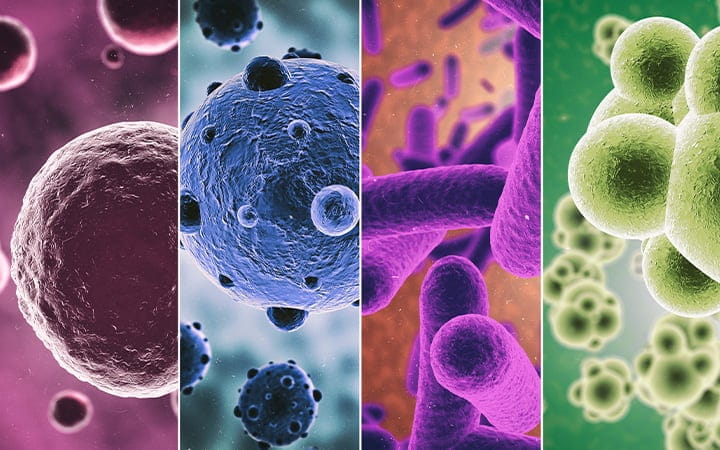Is Your Infection Bacterial or Viral?
December 22, 2022

Coughing, sneezing, fever, vomiting, diarrhea and fatigue? All of these symptoms can be signs that your immune system is working to rid your body of an infectious organism (bacterium or virus) that is making you sick. If either of these tiny microbes invade the body they can cause similar symptoms and lead to mild, moderate or severe disease. But how do you know if your illness is bacterial or viral? And how are they treated?
Bacterial Infections vs. Viral Infections
Bacteria and viruses are both microbes – too small to be seen without a microscope – and both can cause illness in people and animals. Bacterial and viral illnesses can spread through:
- Coughing and sneezing
- Intimate contact with infected people such as kissing or sex
- Contact with contaminated surfaces
- Ingestion of contaminated food or water
- Contact with infected pets, livestock or insects such as fleas or ticks
In other ways, however, they are very different.
What Are Bacteria?
These microbes are single-celled creatures that exist in nature and in the human body. Most are harmless (less than one percent of bacteria cause symptomatic illness in people) and many are actually helpful and necessary for digestion and other physiological processes. Bacteria can reproduce on their own and do not require a host to survive.
Some well-known examples of bacterial infections include:
- Bacterial meningitis
- Bacterial pneumonia
- Gastroenteritis (food poisoning)
- Some ear, skin or sinus infections
- Some sexually transmitted diseases (STDs)
- Strep throat
- Urinary tract infections
- Whooping cough (pertussis)
What Are Viruses?
These microbes are much smaller than bacteria and most will cause symptomatic illness if they invade the human body. A viral organism can’t survive without a host and reproduces by attaching to cells and “reprogramming” them to make duplicate copies of itself.
Some well-known examples of viral infections include:
- Chickenpox and shingles
- Common cold
- COVID-19
- Hepatitis
- HIV/AIDS
- Influenza (flu)
- Measles, mumps and rubella
- Respiratory syncytial virus (RSV)
- Rotavirus
- Some ear infections
- Viral meningitis
- Viral pneumonia
Diagnosis of Bacterial and Viral Infections
Some infections have a distinct set of symptoms and are relatively easy to recognize and diagnose as either viral or bacterial. In other cases, such as with pneumonia, meningitis and some ear infections, it is more difficult to determine if the infection is bacterial or viral.
“There are certain indicators in a complete blood count (CBC) that can help us distinguish between bacterial and viral infections,” says Dana Habash-Bseiso, MD, internal medicine specialist at University Hospitals. “Typically, in bacterial infections we will see an increase in the white blood cell count (leukocytosis) whereas in viral infections there will be a decrease (leukopenia). Blood test results are considered along with the patient’s symptoms and symptom severity to make a diagnosis.”
“Additional tests may include taking a tissue sample (throat swab or skin scraping) or a sample of stool, urine, spinal or nasal fluid for examination under a microscope. Of course, the sample taken will depend on the suspected infection, but for the most part there are some very clear signs that help us make the distinction between bacterial and viral illnesses,” adds Dr. Habash-Bseiso.
Treatment of Bacterial and Viral Infections
If the infection is confirmed to be bacterial, your doctor will most likely prescribe a course of antibiotics. There are many types of antibiotics that work in different ways – some kill the bacteria by destroying the cell wall while others interfere with the bacteria’s ability to reproduce or disable their ability to make the nutrients needed to survive. Your doctor will determine the best type of antibiotic to fight your infection.
Antibiotics are not effective against viruses and should not be taken unless there is clear evidence of a bacterial infection. Overuse of antibiotics can lead to antibiotic-resistant bacteria and make future infections more difficult to treat.
Treatment for most viral illnesses is primarily symptom management as you wait for your immune system to fight the infection. Treatments may include over-the-counter fever reducers, drinking plenty of fluids to stay hydrated, getting lots of rest and, in some cases, taking antiviral medications when appropriate.
Prevention is the Best Medicine
Prevention is one of the best ways to protect you and your family from viral and bacterial illnesses. Frequent handwashing, proper food handling, covering your cough or sneeze and making sure both children and adults receive the recommended and available vaccinations can help everyone stay healthy.
“We can all play an important role in preventing the transmission of viral illnesses. As we enter the cold and flu season and continue to fight COVID-19, getting vaccinated is more important than ever,” says Dr. Habash-Bseiso. “Remember, viruses cannot live without a host. If we all get vaccinated, the virus has nowhere to go so eventually it weakens and goes away. And that’s good news for everyone!”
Related Links:
University Hospitals has a network of primary care providers across the region with the expertise to diagnose and treat all types of viral and bacterial infections. When advanced care is required, our patients have immediate access to UH specialists for comprehensive treatment and symptom management.


